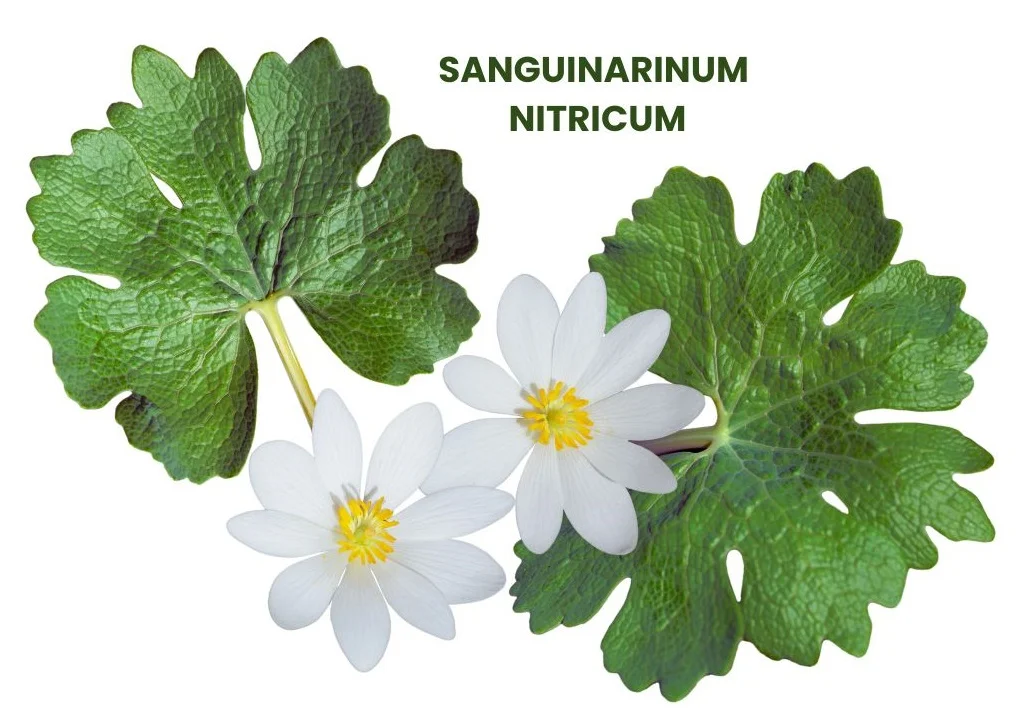Sanguinarinum Nitricum, also known as Nitrate of Sanguinarine, is a homeopathic remedy derived from the alkaloid Sanguinarine found in the bloodroot plant.
This remedy is particularly useful for conditions affecting the respiratory tract and nasal passages, such as polyps, catarrh, and pharyngitis.

Table of Contents
ToggleSOURCE INFORMATION
Scientific Classification
- Kingdom: Plantae
- Clade: Angiosperms
- Clade: Eudicots
- Order: Ranunculales
- Family: Papaveraceae
- Genus: Sanguinaria
- Species: Sanguinaria canadensis (source of Sanguinarine)
Origin and Historical Facts
- Sanguinarine is an alkaloid extracted from the bloodroot plant, Sanguinaria canadensis, native to North America.
- Traditionally, Native Americans used bloodroot for its medicinal properties, including treating respiratory and inflammatory conditions.
- Homeopathic use of Sanguinarinum Nitricum focuses on its ability to address symptoms related to nasal polyps, catarrh, and throat inflammations.
DRUG PATHOGENESIS
- Sanguinarinum Nitricum exhibits a marked action on mucous membranes, particularly those of the respiratory tract.
- It helps alleviate symptoms of congestion, inflammation, and mucous production.
- The remedy is beneficial in both acute and chronic conditions, providing relief from irritation and facilitating the expulsion of mucus.
KEY CHARACTERISTICS
- Polypus of the Nose: Effective in reducing nasal polyps.
- Catarrh: Both acute and chronic catarrh, particularly with burning and smarting sensations in the throat and chest.
- Pharyngitis: Acute and chronic pharyngitis, with symptoms of rough, dry, and burning throat.
- Influenza: Addresses symptoms such as lachrymation, pain in the eyes and head, and sore scalp.
DETAILED ORGAN SYMPTOMS
NOSE
- Sensation of Obstruction: A feeling of blockage in the nasal passages, making breathing difficult.
- Profuse, Watery Mucus: Excessive, clear nasal discharge accompanied by a burning sensation.
- Enlarged Turbinates: Swelling of the turbinates (structures inside the nose) at the onset of hypertrophy (enlargement) process.
- Scant Secretion with Dryness: Minimal nasal mucus production with a tendency for the nasal passages to feel dry.
- Small Crusts that Bleed: Formation of small scabs in the nose that bleed when removed.
- Post-nasal Secretions: Mucus accumulates at the back of the nasal cavity and sticks to the nasopharynx, making it hard to clear.
- Rawness and Soreness: A feeling of irritation and soreness in the back part of the nasal passages.
THROAT
- Rough, Dry, and Burning Sensations: The throat feels raw, dry, and as if it is burning.
- Soreness in the Right Tonsil: Pain and discomfort specifically in the right tonsil.
- Difficulty in Swallowing: Challenges in swallowing food or liquids smoothly.
MOUTH
- Ulceration on the Side of the Tongue: Sores or ulcers appear on the tongue, causing discomfort and pain.
RESPIRATORY SYSTEM
- Short, Hacking Cough: Persistent, dry cough that produces thick, yellow mucus with a sweetish taste.
- Pressure Behind the Sternum: A feeling of pressure or heaviness in the center of the chest.
- Dryness and Burning in Throat and Bronchi: A sensation of dryness and burning along the respiratory tract, particularly in the throat and bronchial tubes.
- Tickling Cough: A cough induced by a tickling sensation in the throat.
- Chronic Nasal, Laryngeal, and Bronchial Catarrh: Long-term inflammation of the mucous membranes in the nose, larynx, and bronchi, leading to mucus production and congestion.
- Altered, Deep, Hoarse Voice: Changes in the voice, making it sound deeper and hoarser than usual.
MODALITIES
- Worse: Symptoms often worsen with exposure to cold air and during dry weather.
WHAT ARE MODALITIES IN HOMOEOPATHY?
RELATIONSHIP WITH OTHER DRUGS
Compare with,
- Sanguinaria Tartarica: Useful for exophthalmos, mydriasis, and dim vision.
- Arum Triphyllum: Effective for similar nasal and throat conditions.
- Psorinum: Helps in chronic conditions with catarrh.
- Kali Bichromicum: Known for its action on mucous membranes, particularly in thick, sticky secretions.
DOSE
- Third Trituration: Typically administered in the third trituration for optimal efficacy.
Frequently Asked Questions (FAQs)
What conditions can Sanguinarinum Nitricum treat?
- It is effective for nasal polyps, acute and chronic catarrh, pharyngitis, and respiratory conditions with excessive mucus production.
How is Sanguinarinum Nitricum administered?
- It is usually given in the third trituration form.
Can Sanguinarinum Nitricum be used for throat ulcers?
- Yes, it can help alleviate symptoms associated with throat ulcers and other mucous membrane irritations.
Is Sanguinarinum Nitricum safe for long-term use?
- As with any homeopathic remedy, it should be used under the guidance of a qualified practitioner, especially for long-term treatment.
Glossary of Difficult Words
- Polypus: A polyp, a small growth typically benign, found in the nasal passages.
- Catarrh: Inflammation of the mucous membranes with increased mucus production.
- Pharyngitis: Inflammation of the pharynx, causing a sore throat.
- Lachrymation: Excessive tearing of the eyes.
- Turbinates: Long, narrow bones in the nasal passage that help to warm and humidify the air.
- Hypertrophic: Enlargement or overgrowth of an organ or part due to the increased size of its constituent cells.
- Nasopharynx: The upper part of the throat behind the nose.
- Trituration: A process of grinding a substance to a fine powder, used in homeopathy to prepare remedies.
